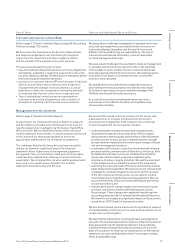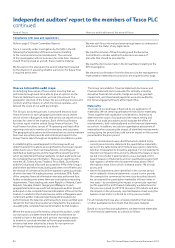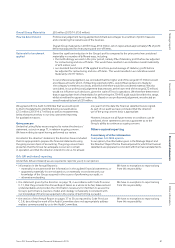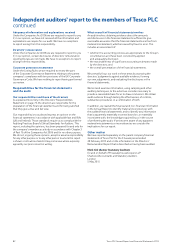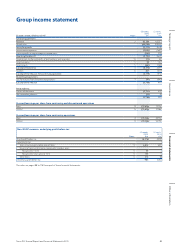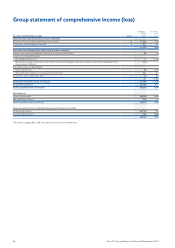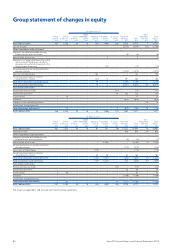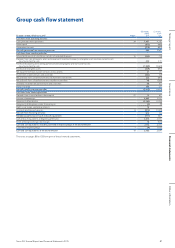Tesco 2015 Annual Report Download - page 79
Download and view the complete annual report
Please find page 79 of the 2015 Tesco annual report below. You can navigate through the pages in the report by either clicking on the pages listed below, or by using the keyword search tool below to find specific information within the annual report.
Area of focus How our audit addressed the area of focus
Commercial income – impact on prior periods
Refer to page 37 (Audit Committee Report), page 88 (Accounting
Policies) and page 99 (notes).
The Group has stated in its financial statements that commercial
income recognised in previous periods was overstated by £53
million in 2013/14 and by £155 million in the periods prior to
2013/14. The directors have concluded that it is not possible to
determine the exact amounts relating to prior periods and exactly
which periods are affected. Management has however produced
a quantitative and qualitative estimate of the amounts relating
to prior periods.
Having estimated the amounts of potential misstatement relating
to prior periods, the directors then assessed whether these
amounts are material such that the prior period financial
statements would require restatement. The directors concluded
that the amounts relating to prior periods, whilst significant, were
not, from an accounting perspective, material and consequently
that it is not necessary to restate the 2013/14 financial statements.
We challenged and evaluated management’s quantitative and
qualitative analysis of amounts relating to prior periods and, whilst
judgemental, we considered that assessment to be reasonable.
The estimated impact on 2013/14 profits was £53 million, which was
below our profit based materiality of £150 million that we
determined applicable for the 2013/14 audit. The estimated impact
on the 22 February 2014 and 23 February 2013 balance sheets was
£208 million and £155 million respectively, both of which are less
than 0.5% of the Group’s total assets at each respective period end.
The basis on which we considered materiality relating to prior period
items is explained further below.
After considering carefully the nature and the quantum of the
estimated amounts relating to prior periods we concurred with the
directors that these amounts, whilst significant, were not material
and the prior period financial statements did not require restating.
The estimated impact on prior periods has been charged to the
income statement in the current period and the Group has
separately identified this as a one-off item. We concurred with this
accounting treatment and are supportive of the detailed disclosures
made in the Annual Report about the impact of the misstatement on
the prior periods’ financial statements.
Impairment of property, plant and equipment
Refer to page 37 (Audit Committee Report), page 88 (Accounting
Policies) and page 108 (notes).
The directors have recorded an impairment charge of £4,292
million against the carrying value of property, plant and
equipment across the Group.
We focused on this area because the determination of whether
or not an impairment charge for property, plant and equipment
was necessary involved significant judgements by the directors
about the future results of the business and assessment of future
plans for the Group’s property portfolio in a number of territories.
In particular we focused on the reasonableness and impact of key
assumptions including:
• the cash flow forecasts derived from internal forecasts and
the assumptions around the future performance;
• the discount rate and the long term growth rate including
the assessment of risk factors and growth expectations
of the relevant territory; and
• the assumptions used in the valuations prepared to support
the fair value of certain assets and also the assessment of
the external valuers as management’s expert.
We evaluated management’s impairment calculations in local
territories, assessing the future cash flow forecasts used in the
models, and the process by which they were drawn up, including
comparing them to the latest Board approved budgets, and
we tested the mechanics of the underlying calculations. We
understood and challenged:
• the assumptions used in the Group’s five-year Plan and the
long term growth rates by comparing them to economic and
industry forecasts;
• the discount rate by assessing the cost of capital and other
inputs and comparable organisations; and
• the assumptions used by the external valuers to determine
the fair market value of the assets.
In performing the above work we utilised our specialist forecasting
and valuations knowledge to provide challenge and external market
data points to assess the reasonableness of the assumptions used
by management.
We performed sensitivity analysis around the key drivers of growth
rates within the cash flow forecasts to ascertain the extent of
change in those assumptions that either individually or collectively
would be required for the assets to be further impaired and also
considered the likelihood of such a movement in those key
assumptions arising.
Whilst recognising that cash flow forecasting, impairment modelling
and property valuations are all inherently judgemental, we concluded
that the assumptions used by management were within an acceptable
range of reasonable estimates.
77Tesco PLC Annual Report and Financial Statements 2015
Other informationGovernance Financial statementsStrategic report














